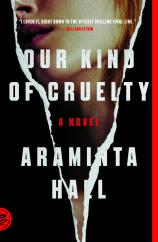Reading Group Guide
Discussion Questions
Our Kind of Cruelty

1. As the book begins, Mike Hayes, the narrator and main character, is in prison. His barrister has told him to write down the story of events leading to the murder for which he will soon go to trial. Why does the barrister say that Mike’s story feels like “something he can’t grab hold of”? What are clues in Part I that Mike’s version of events may not be accurate? Are there things he tells us about himself that reveal more than he intends?
2. When Mike and Verity met, as students at university, they were both promising young people from very different backgrounds. What initially drew them together? What challenges did they each face and how were they suited to help each other? As their relationship progressed over nine years, how did they each change?
3. What is the Crave, the game Mike and Verity play? How did it begin and how was it named? What does Mike read into Verity’s e-mails and meetings with him that make him believe her marriage to Angus is “the ultimate Crave”?
4. Why does Verity invite Mike to the wedding? Why does she get back in touch with him at all?
5. What is Kaitlyn’s motivation for befriending Mike? How does he interpret her kindness? What does she mean when she says they are both outsiders at work? How does she come to suspect that he is not what he seems?
6. “Eagles are magnificent,” Verity tells Mike, explaining to him why she wears a necklace with a silver eagle on it. What does the eagle mean to her? What does it mean to Mike?
7. Mike’s childhood was a combination of cruelty and kindness --- a boyhood of damaging cruelty, followed by foster care with Elaine and Barry, who loved him and tried to repair the damage done to him by his mother and her boyfriends. What are instances of kindness and cruelty toward Mike or between other characters? How does Mike respond to kindness? What is his idea of love?
8. What is in the box that Elaine gives Mike when he goes away to university? Which objects are meaningful to him? Even though he says he meant to throw it away at the first opportunity, why has he kept it? How is Mike a combination of the cruelties and kindnesses that the objects in the box represent?
9. What is the sequence of events leading to Angus’s death? Are there signs that Mike is an angry man who might be capable of killing? Who else might bear some of the responsibility for Mike’s actions?
10. The testimony given at the trial often challenges Mike’s version of events. For example, he tells us that Verity’s friend Louise made a pass at him at Verity’s wedding. But Louise testifies that she had never liked Mike, that he was agitated at the wedding and had pushed her. Which version of the story is more believable? What are other examples of testimony that contradict Mike?
11. “I am well practiced in ruining things,” Mike thinks as he remembers the events leading to Angus’s death. What leads him to make this observation? Is he a confused and grieving man who has been betrayed by circumstance or a man who deliberately chooses to do wrong --- the dangerous fantasist invoked by Petra Gardner or the confused “good lad” his foster mother believes him to be? Does he deserve any sympathy?
12. Besides Verity, are there other people who matter to Mike? How would they describe him? How do his impulses, either cruel or kind --- toward his foster parents, co-workers, neighbors and acquaintances --- intensify during the months after Verity leaves him?
13. The media covers the trial as a scandal and relishes in reporting every detail of Verity’s background and relationships. Why are the press and public opinion more focused on her than on Mike? Why do they seem eager to assume she is guilty? Is she treated fairly in court?
14. As the book ends, Mike receives the YOU ARE NOT postcard from Verity. Why did Verity send the postcard? How does Mike interpret her message? Why does he believe he has “saved” her?
15. The epigraph that opens the book (from THE SEA, THE SEA by Iris Murdoch) implies that OUR KIND OF CRUELTY is essentially a love story. Is it? What else does the epigraph foreshadow?
Guide written by Patricia Daneman
Our Kind of Cruelty
- Publication Date: May 7, 2019
- Genres: Fiction, Psychological Suspense, Psychological Thriller, Romance, Suspense, Thriller
- Paperback: 288 pages
- Publisher: Picador
- ISBN-10: 1250214939
- ISBN-13: 9781250214935







